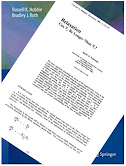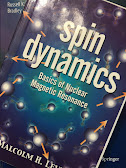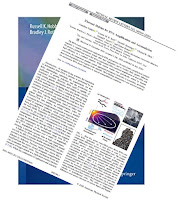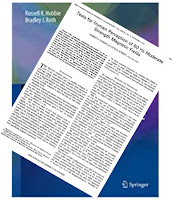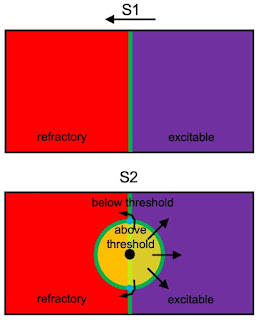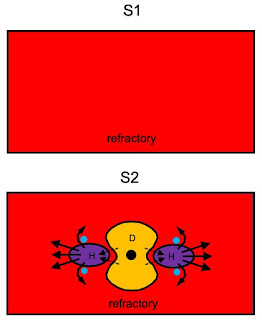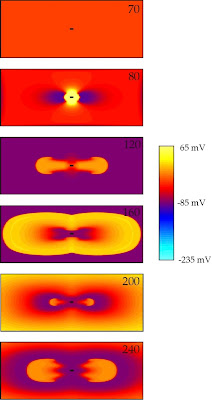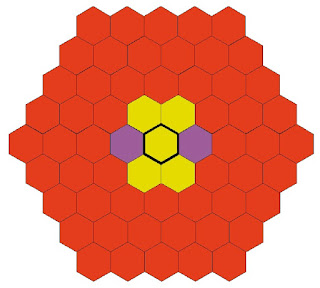One weakness of Intermediate Physics for Medicine and Biology is that it doesn’t have an associated laboratory. Students need to learn how to perform experiments and use instruments.
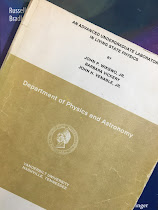 |
| An Advanced Undergraduate Laboratory In Living State Physics, by Wikswo, Vickery, and Venable. |
Wikswo obtained a grant from the National Science Foundation to support the development of the lab. He collaborated with John Venable, a biologist on the Vanderbilt faculty. When I was a graduate student, Venable was the
Associate Dean of the College of Arts and Sciences.
Barbara Vickery was a Vanderbilt undergraduate biomedical engineering major.
The lab wasn’t designed for any particular textbook, but Wikswo was an early adopter of Russ Hobbie’s Intermediate Physics for Medicine and Biology, and I think I can see its influence. I don’t have an electronic copy of the 250-page lab manual; you would have to contact Wikswo for that. Below I quote parts of it.
1.1 An Introduction to the Living State Physics LaboratoryThe first time I ever saw my wife was when she was in Wikswo's office asking a question about one of the lab exercises. I needed to talk to him about some very important issue related to my research, and she was in the way! Well, one thing led to another and....
The undergraduate physics curriculum at a typical university might include an introductory class in biophysics or medical physics in addition to the more traditional curriculum of mechanics, electricity and magnetism, light and sound, thermodynamics, and modern physics. While introductory and advanced laboratory classes cover these standard fields of physics, generally there has been little opportunity for an undergraduate student to gain laboratory experience in biophysics or medical physics. The need for such experience is particularly acute today for preprofessional and scientifically oriented students. Of these students, physics majors are not being exposed to an important area of experimental physics, and pre-medical students and majors in other departments such as Molecular Biology, Chemistry, and Biomedical Engineering are presently receiving only a minimal exposure to modern biophysical techniques and instrumentation. Thus by introducing an advanced undergraduate laboratory in physics applied to living systems, we expect to broaden the experience in experimental physics for physics majors and non-majors alike.
Several options were available to us in designing this laboratory. We could, for example, have structured the laboratory to emphasize applications of physics to certain living systems such as the nervous system, the cardiovascular system, and the special senses. Rather than take this system-oriented approach, we have chosen to organize the course by areas of physics. The course will draw on techniques and ideas from the whole breadth of physics (mechanics, electricity, thermodynamics, optics, etc.) and apply these to topics of biophysical interest [the same approach as IPMB]. Since we will study intact living systems such as people and frogs, as well as isolated living preparations and inanimate molecules and models, this laboratory will use physics to study topics conventionally identified with both biophysics and medical physics, as well as with electrophysiology, physical chemistry, biomedical engineering and molecular biology. Because of the intended breadth of the planned experiments and their organization by area of physics rather than by biological system, we have chosen to title this laboratory “An Advanced Undergraduate Laboratory in Living State Physics”. The generality of the term “Living State Physics” is intended to parallel the generality of the term “solid state physics”, which as an experimental discipline utilizes the complete spectrum of physical concepts and techniques...
1.2 Summary of Experiments
a. Introduction to Bioelectric Phenomena. The first of the three experiments in this section is an exercise with an oscilloscope and an electronic stimulator which will allow the student to obtain a familiarity with the use of these instruments. In the second and third experiments, the Thornton Modular Plug-In System is used to provide familiarity with the basic physics describing the electromyogram and the electroencephalogram…
b. The Heart Experiments. This section should enable the student to gain an understanding of the basic principles of cardiac physiology. In the laboratory, the student will measure the frog and the human electrocardiogram…
c. Nerve Action Potential… [Students perform an] in-depth study of the properties of nerve propagation in the isolated sciatic nerve of a frog. In both experiments, from extracellular recordings of the nerve action potential it will be possible to demonstrate the graded response of the nerve bundle, the strength-duration relationship of stimuli producing a threshold response, bi-directional conduction, and the monophasic response…
d. Nerve Modeling. In the first experiment, the passive cable properties of the nerve are studied by using a resistor-capacitor network that represents a section of a nerve axon… The active properties of the nerve are investigated in the second experiment. An electronic nerve model which has a design based on a system of equations similar to those developed by Hodgkin and Huxley is used…
e. Skeletal Muscle. The first of the two experiments in this section is an introduction to the active and passive mechanical properties of skeletal muscle using the frog gastrocnemius muscle. The experiment includes measurement of the muscle twitch, the ability of the muscle to do work, and the maximum tension developed by the muscle at different lengths, as well as demonstration of the phenomena of temporal summation and the graded response of muscle. The second experiment involves characterization of the mechanical properties of muscle in its resting and contractile states…
f. Diffusion. In this experiment, a Cenco model is used for qualitative demonstration of the transport phenomenon of diffusion, showing the exponential approach to equilibrium and how the relative sizes of molecules and pores affect diffusion rates.
g. Compartmental Modeling. The usefulness of compartmental modeling in analysis of some systems is demonstrated by constructing one- and two-compartment models for several open and closed thermal systems. The theoretical models are analyzed mathematically…
h. The Physical Aspects of Vision. The minimum number of photons that the human eye can detect in a single detectable flash is the minimum number of photons whose absorption by photoreceptor cells in the eye leads to the firing of an impulse in the brain. This threshold value is determined by recording the fraction of detected flashes as a function of relative intensity of the flashes… by utilizing Poisson statistics.
i. Ultrasound… The experiments introduce the physics of mechanical waves by using ultrasound transducers, a two-dimensional ultrasound target, and an existing ultrasound scanner and transient analyzer to demonstrate wave propagation, attenuation, reflection, refraction, pulse-echo principles, piezoelectric crystals and the concepts of cross-section and spatial resolution.
I recall how Shirley and my friend Ranjith Wijesinghe were lab partners doing the vision experiment. It required sitting in a small, dark enclosure for about half an hour while their eyes became adapted to the dark. I had only recently met Shirley, and I recall being jealous of Ranjith for getting to spend such a private time with her!
One of the most memorable parts of the lab was the pithing of the frog. None of the students liked doing that. Wikswo had a fun way of demonstrating the fight-of-flight response during the electrocardiogram lab. He would measure the ECG on one of the students, and then take out a giant syringe and say something like “now watch what happens to her heart rate when I inject her with this adrenaline.” Of course no one ever got injected, but the student was always so startled that her heart rate would jump dramatically.
If you are considering developing you own laboratory for Intermediate
Physics for Medicine and Biology, you could start with Wikswo’s lab, and
then add some of the experiments discussed in these American Journal of Physics papers. Good luck!
J. D. Prentice and K. G. McNeill (1962) “Measurement of the Beta Spectrum of I128 in an Undergraduate Laboratory,” American Journal of Physics, Volume 30, Pages 66–67.
Peter J. Limon and Robert H. Webb (1964) “A Magnetic Resonance Experiment for the Undergraduate Laboratory,” American Journal of Physics, Volume 32, Pages 361–364.
L. J. Bruner (1979) “Cardiovascular Simulator for the Undergraduate Physics Laboratory,” American Journal of Physics, Volume 47, Pages 608–611.
H. W. White, P. E. Chumbley, R. L. Berney, and V. H. Barredo (1982) “Undergraduate Laboratory Experiment to Measure the Threshold of Vision,” American Journal of Physics, Volume 50, Pages 448–450.
Colin Delaney and Juan Rodriguez (2002) “A Simple Medical Physics Experiment Based on a Laser Pointer,” American Journal of Physics, Volume 70, Pages 1068–1070.
Danny G. Miles Jr. and David W. Bushman (2005) “Protein Gel Electrophoresis in the Undergraduate Physics Laboratory,” American Journal of Physics, Volume 73, Pages 1186–1189.
Luis Peralta (2006) “A Simple Electron-Positron Pair Production Experiment,” American Journal of Physics, Volume 74, Pages 457–461.
Joseph Peidle, Chris Stokes, Robert Hart, Melissa Franklin, Ronald Newburgh, Joon Pahk, Wolfgang Rueckner, and Aravi Samuel (2009) “Inexpensive Microscopy for Introductory Laboratory Courses,” American Journal of Physics, Volume 77, Pages 931–938.
Timothy A. Stiles (2014) “Ultrasound Imaging as an Undergraduate Physics Laboratory Exercise,” American Journal of Physics, Volume 82, Pages 490–501.
Elliot Mylotta, Ellynne Kutschera, and Ralf Widenhorn (2014) “Bioelectrical Impedance Analysis as a Laboratory Activity: At the Interface of Physics and the Body,” American Journal of Physics, Volume 82, Pages 521–528.
Alexander Hydea and Oleg Batishchevb (2015) “Undergraduate Physics Laboratory: Electrophoresis in Chromatography Paper,” American Journal of Physics, Volume 83, Pages 1003–1011.
Owen Paetkau, Zachary Parsons, and Mark Paetkau (2017) “Computerized Tomography Platform Using Beta Rays,” American Journal of Physics, Volume 85, Pages 896–900.



